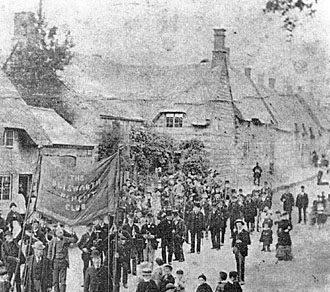|
The Brafields of Blisworth
A site very close to the Manor was identified, mistakenly, by the Ordnance Survey team in c1850 as the site of the Wake family seat, until c1540, and a mark has appeared upon their maps from 1880 to about 1970 proclaiming this ancient feature. However, the OS had confused this with the larger house - Blisworth House. From the details of the Crown Lands Purchases we learn that a Charles Brayfield was freeholder from 1649 to 1660 of what might be estimated to be 190 acres in Blisworth. This Charles Brayfield was likely to be a yeoman (equivalent to a Justice of the Peace) and influential. He may well have secured a mortgage in order to quickly respond to the sale terms. Then, sixty seven years later another Charles, the one mentioned in the paragraph above, is recorded on a map as a tenant in 1727. Rent books claim a Charles as tenant from 1740, being the first of the surviving books. There are certainly at least two Charles's in the family from 1649 to 1783. This second Charles was also important in the village, being made a thirdborough (assistant Constable) in 1740. An impressive family tree, recorded in ancestry.co.uk files, has been kindly shown to me by Jan Royal, a descendant of the Brafields in Blisworth. Her tree shows a record that the second (the last) Charles as being born in 1694 in Blisworth and dying in 1778. The farm was relinquished in 1783 when his son Edward died. The tree also claims a provisional record for a William Brafield who died, yeoman farmer, in Blisworth in 1621 and a John Brafield who died in 1647. The lifetimes of these two, if in Blisworth, would have seen virtually all the oldest cottages being significantly refurbished or freshly built whilst Blisworth was incorporated into the Honour of Grafton. It is thought that William originated from Hanslope. At the other end of the range of dates in Blisworth we can see that John, Edward Trotter and Ann Brafield were born in 1780, 1781 and 1782 respectively, to Ann Howard (no data) and the above-mentioned Edward shortly before his death aged 45. These children being the grand-children of the last Charles. Interestingly the second boy was given the name Trotter, no doubt from the rector at the time who must have been a friend of the family - Rev. Nathaniel Trotter (Rector from 1762 - 1797). These three children were the last of the Brafields to be born in Blisworth. Another interesting point is that Edward Trotter Brafield is recorded born at number 40 High Street, Blisworth. We must bear in mind that house numbers in Blisworth were almost never mentioned and were not organised until 1952, to help the postal services when their base was moved to Northampton. In Victorian times the post was collected from trains and sorted in a stone-built hut in the High Street so the post staff would know everybody and there was no need for house numbers - there being a clear indication of this in a local directory dated 1936. Anyway, in 1952 the site of Manor House, ie. the brick "Manor" house was numbered 46 not 40, with C. F. Burbidge in residence. This coincidence is testament to a fair preservation in the number of doors in the High Street and an interesting early application of the convention to begin numbering at the "Townsend", with even numbers on the right-hand side. Another surprise is that the street that goes right through the village was called High Street in 1781. In mid-19C, the lower half was called Bridge Street for a while - perhaps to help people locate the canal! All three of these children of Edward's left Blisworth. John left when he married Mary Cooke - see below. Edward Trotter became a cabinet-maker and bedstead-maker in the Tottenham Court Road, London, recorded as such as early as in 1822 (Pigot's directory). His sister Ann married William George of Gayton in 1804 and so also left Blisworth. She had no children and died in Roade in 1856 while her husband lived on for a while in Gayton. After the last births in Blisworth in the 1780s, nearly another twenty years go by before 7 children are born in Tiffield from 1801 - 1816 to John Brafield and Mary Cooke (m. at Whittlebury in 1801) - John Cooke, Edward, William, Sarah, Thomas, Agnes and Mary Ann. It appears that John Brafield decided to settle in Tiffield, where similar farms to those in the Grafton Estate could be rented from the Fermor family. Perhaps John Brafield could see the benefit in not having to endure an industrial Blisworth that surely ensued upon the arrival of the canal. It is thought that the great majority of Brafields in Northamptonshire came from this line. The span from c1600 to 1800 in which the Brafield family were resident in Blisworth covers a period of many political changes that impacted on rural life and, with the arrival of the canal in 1796, Blisworth saw the dawn of the industrial revolution in the form of transportation (rail and canal) and local quarrying and mining.
Tony Marsh, with much help from Jan Royal, October 29, 2009 |
